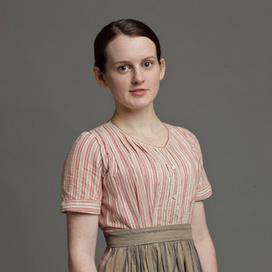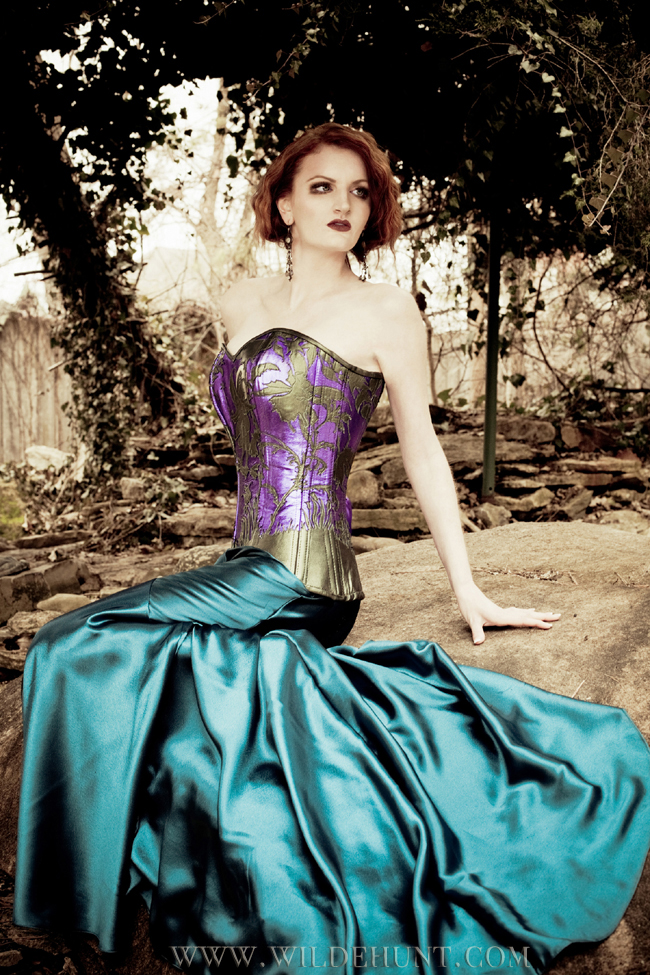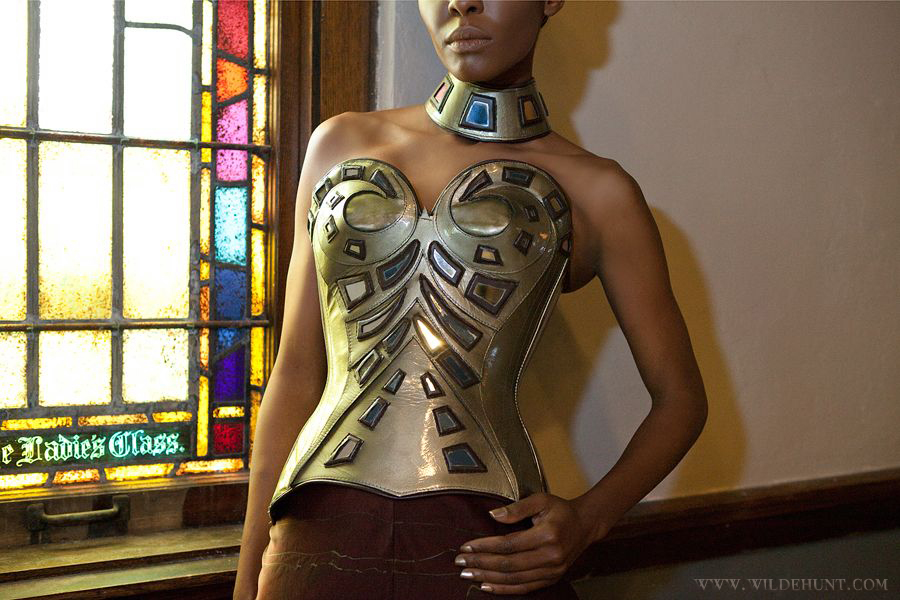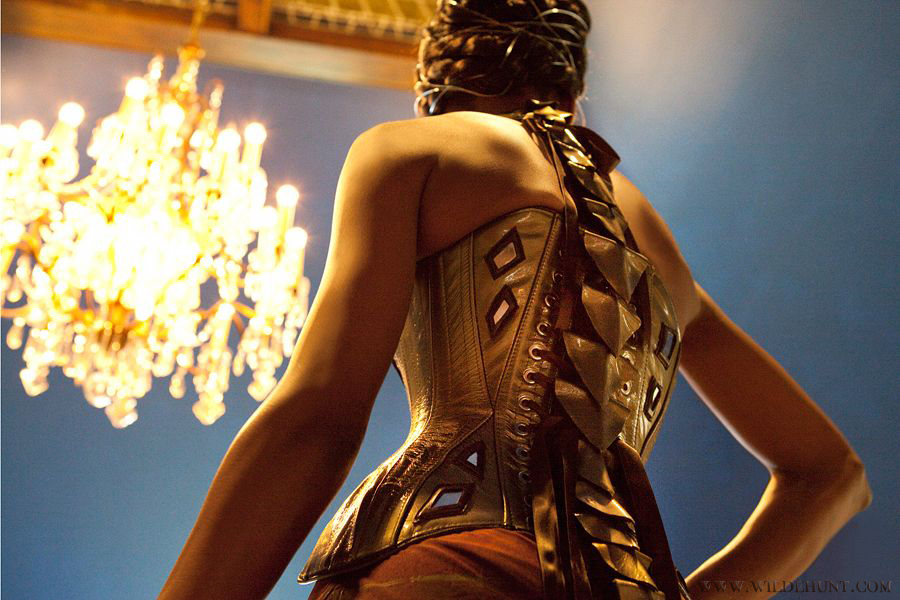I love how a corset top highlights an hourglass figure, and I even purchased an off-the-rack Grenier corset a few years ago. Back then I told you how great it was to be able to use the laces to make it fit a larger bust, but back then I didn’t realize that my method of making it fit was simply smashing my boobs under my arms. You can avoid the underarm boob smash by either (1) purchasing an underbust corset like the What Katie Did Morticia reviewed by Georgina and Cheryl, or (2) ordering a custom-made overbust corset like the ones made by Larissa Boiwka of Wilde Hunt Corsetry.
When I discovered Larissa through the Fashion Incubator forum recently, I had a lot of questions for her, and I thought you’d be interested in her answers.
1. Where does everything go?
Your size doesn’t change when you wear a corset, but the placement of everything makes you look smaller. Larissa calls it “vertical compression”. Lacing down brings everything in and up, including your boobs. In a custom corset, your boobs aren’t smashed under your arms because a good corsetiere will take it in at the waist but add to the bust. This explains why the room for your bust may be larger than your natural measurements.
2. Who wears corsets?
I have worn my own corset out of the house a grand total of ONE time, and that was under a dress for a date night. So I wanted to know who wears Larissa’s corsets and where? Although her corsets can easily be worn beneath other clothing, they are intended for outerwear. Usually a Wilde Hunt corset is commissioned for a special occasion, such as a client’s recent 40th birthday party, and there is no one “type” of customer. Larissa’s clients have included:
- Â an outgoing vaudeville performer;
- a shy and conservative woman who wanted something dramatic in her life;
- an Iraq war veteran who commissioned a pinup corset with insignia on it;
- the owner of a prestigious art gallery;
- the owner of a tattoo and piercing parlor;
- a California doctor that Larissa later heard quoted on NPR for an important study.
Recently Larissa has created a bridal line. Imagine the versatility of being able to wear your bridal corset after the wedding–you could even have the leather painted a different color (Larissa cautioned me that dyeing it could cause the coating of the steel to crack).

Back to who wears corsets, when I watched the first season of Downton Abbey, I was obsessed with trying to identify the outlines of corsets under the costumes. “Did everyone wear corsets back then?” I asked Larissa. Yes. She told me about an advertisement she’d seen from that period for a corset called “The Pretty Maid” that was designed for servants–working corsets tended to be shorter and more functional. They even had ventilated corsets for hot weather.

3. Isn’t it hard to get the right fit remotely?
Surprisingly, no. Larissa conducts fittings via snapshots from all angles to determine where to sculpt. A customer will first be photographed with the laces loosely tied and again after they are tightened. One customer had her neighbors take the photographs–two 70-year-old twin nuns. Larissa wishes she had a photograph of the photographers!
When Larissa studies the photos, she is concerned with what she calls “negative ease”. When I create my Campbell & Kate shirts, I’m concerned about giving the wearer enough ease in the waist and bust to be able to move comfortably. Larissa, on the other hand, is concerned with taking that ease away. She finds that working with steel and leather is very similar to actual sculpting.
It can take as many as three photo sessions to get the fit perfect for a woman with a large bust.
4. What’s her favorite corset?
Larissa’s favorite corset is always the one she’s currently working on.
She created the Ammonite corset as a personal challenge. It has a three-dimensional spine feature that mimics a vertebral column and is ornamented with mirrors set in pearlized patent leather. A typical pattern consists of 10-12 pieces, but this one consisted of 18 different pattern pieces.
You can probably tell from these photos that Larissa watches a lot of fantasy and science fiction (wouldn’t the Ammonite be perfect in a movie?). She also has a degree in anthropology, so she is very interested in cultural dress.
5. How does a client decide on a design?
The possibilities are endless, but Larissa is careful not to overwhelm. After talking to a customer, Larissa hones in on what the customer is really looking for and sends her a few sketches. Of course price will be a factor as well. Wilde Hunt overbust corsets begin at $600, and Larissa walks a customer through the price ranges for each option.
Do you have more questions?
I do. I want to know:
1. the time range from commission to final product;
2. whether the mockup is created in leather or fabric;
3. the advantages of using leather (i.e., more breathable, moldable, etc.); and
4. if Larissa has ever created (or would consider creating) corsets as built-ins to other designers’ dresses (such as a wedding gown).
What would you like to know?
Look for Larissa’s answers in the comments over the next few days.



Hi Darlene! Thanks for such a nice article!
Here are some answers –
1. the time range from commission to final product;
I try to allow approximately 3 months from start to completion. If my work load is heavier, it may take more time or I may be working with a waiting list but I always advise the client of the situation prior to taking their commission.
2. whether the mockup is created in leather or fabric;
I know that some manufacturers do use leather to make samples for production garments that are mass produced but I create my corset mockups in fabric since I am usually only making one custom corset per client at a time. I can get an accurate idea of fit from fabric and I hate the idea of wasting leather on something that would get thrown away.
3. the advantages of using leather (i.e., more breathable, moldable, etc.);
I am a huge fan of how leather molds to the body. This is especially true with corsets. The longer you wear your leather corset the better it looks. It also stays clean very well and most leathers are very breathable. That breathability is just something that you can not get with PVC or vinyl corsets.
People have recognized that leather is perfect material for corsets for a very long time. Here is a photo of an antique leather corset form the late Victorian or Edwardian era : http://25.media.tumblr.com/tumblr_lg4ej7w6vL1qcddvlo1_500.jpg
I think it’s gorgeous and I’ll take her boots, too!
4. if Larissa has ever created (or would consider creating) corsets as built-ins to other designers’ dresses (such as a wedding gown).
I have not created a built in corset in a gown. It’s on my list! But I have created a corseted sheath dress. You can see it here, in the album called “Deco Corset Dress” http://www.wildehunt.com/gallery-albums/
Thanks again, Darlene! It was great chatting! I’ll keep an eye out on this post to see if there are anymore questions!
Larissa
My corset also squishes my boobs back under my arms, and to make matters worse, the side boning then pokes into the flesh, making it painful to wear for more than a couple of hours. But how do you add bust room to the front of the over-bust corset while keeping the area immediately below the breasts tight enough to support the bust line? Or does this style work better for women who don’t need a lot of support to keep everything up where they want it?
These corsets are gorgeous, and thank you both for such an interesting article.